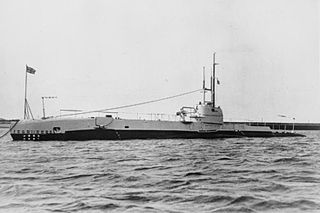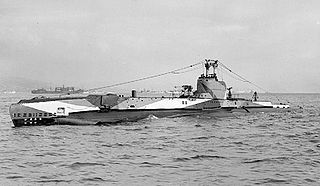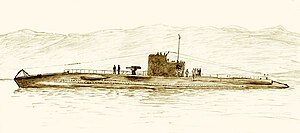The Adua-class submarine was the fourth sub-class of the 600 Series of coastal submarines built for the Regia Marina during the 1930s. There were 17 submarines in this class, almost all named after places in Ethiopia which had been an Occupied by Italy since 1936, but only one, Alagi, survived World War II. Three submarines of this class were sold to Brazil before the war and replaced with submarines of the same names.
The Glauco class was a pair of submarines ordered by the Portuguese government, but were taken over and completed for the Regia Marina during the 1930s. They played a minor role in the Spanish Civil War of 1936–1939 supporting the Spanish Nationalists.

HMS Snapper was a second-batch S-class submarine built during the 1930s for the Royal Navy. Completed in 1935, the boat participated in the Second World War. Snapper is one of the 12 boats named in the song "Twelve Little S-Boats".

HMS Sealion was a second-batch S-class submarine built during the 1930s for the Royal Navy. Completed in 1934, the boat fought in the Second World War.

The Perla-class submarines were the third sub-class of the 600 Series of coastal submarines built for the Royal Italian Navy during the 1930s and named after gemstones. Of the ten boats built of this class, only three survived World War II.

The R-class or Romolo-class submarine was a group of submarines built for the Royal Italian Navy during World War II. They were designed as blockade running transport submarines for transporting high-value cargo from Europe to Japan and vice versa. Axis-occupied Europe lacked strategic materials such as tungsten, tin and some commodities such as rubber.
The Osvetnik class consisted of two submarines built for the Kingdom of Serbs, Croats and Slovenes – Yugoslavia from 1929 on – by Ateliers et Chantiers de la Loire in Nantes, France. Launched in 1928 and 1929, the boats were named Osvetnik (Avenger) and Smeli (Daring). They were built to a partial double hull Simonot design similar to the French Circé-class submarines. Also known as the Smeli class, they were the second class of submarines to serve in the Royal Yugoslav Navy (KM), and after extensive sea trials and testing they sailed from France to the Adriatic coast of Yugoslavia, arriving in December 1929, where they joined the two larger British-made Hrabri-class submarines to make up the pre-war Yugoslav submarine flotilla. The Osvetnik-class were armed with six 550 mm (22 in) torpedo tubes, one 100 mm (3.9 in) gun, and one 40 mm (1.6 in) anti-aircraft gun, and could dive to 80 metres (260 ft).
The Italian 600 Series submarines were a series of submarine classes built for the Italian Royal Navy during the Inter war years.

The Circé-class submarines were a sub-class of the 600 Series of submarines built for the French Navy prior to World War II. There were four vessels in the class, built to a Schneider-Laubeuf design. They were ordered in 1925 and completed by 1927.

The Sirène-class submarines were a sub-class of the 600 Series built for the French Navy prior to World War II. There were four vessels in the class, built to a Loire-Simonot design. They were ordered in 1925 and completed by 1927. Three of the four boats of the Sirène class saw action during the Second World War, from September 1939 until the French armistice in June 1940.
The French submarine fleet of World War II was one of the largest in the world at that time. It saw action during the war but had a chequered service history due to France's position at that time. During the conflict, 59 submarines, more than three-quarters of the fleet, were lost.
The Italian submarine fleet of World War II was the largest in the world at the time, with 116 submarines. It saw action during the Second World War, serving mainly in the Mediterranean. During the conflict 88 submarines, some two-thirds of its total strength, were lost.

The Brumaire-class submarines were built for the French Navy prior to World War I. There were sixteen vessels in this class, of the Laubeuf type.
The Argonaute class were a sub-class of the 600 Series submarines built for the French Navy prior to World War II. There were five vessels in the class, built to a Schneider-Laubeuf design. They were ordered in 1927 and completed by 1935.

French submarine Fresnel (Q65) one of 18 Pluviôse-class submarines built for the French Navy in the first decade of the 20th century.
Osvetnik (Avenger) was the first of the Osvetnik-class diesel-electric submarines built by Ateliers et Chantiers de la Loire, Nantes, France for the navy of the Kingdom of Serbs, Croats and Slovenes. She was launched in 1929, and was built to a partial double hull Simonot design similar to the French Circé-class submarines. She was armed with six 550 mm (22-inch) torpedo tubes, one 100 mm (3.9 in) gun, and one 40 mm (1.6 in) anti-aircraft gun, and could dive to 80 metres (260 ft).
Smeli (Daring) was the second of the Osvetnik-class diesel-electric submarines built by Ateliers et Chantiers de la Loire, Nantes, France for the navy of the Kingdom of Serbs, Croats and Slovenes. She was launched in 1928, and was built to a partial double hull Simonot design similar to the French Circé-class submarines. She was armed with six 550 mm (22-inch) torpedo tubes, one 100 mm (3.9 in) gun, and one 40 mm (1.6 in) anti-aircraft gun, and could dive to 80 metres (260 ft).

Prairial was one of 18 Pluviôse-class submarines built for the French Navy in the first decade of the 20th century. During World War I, Priarial collided with the British steamer Tropic in the English Channel off Le Havre, France, and sank with the loss of 19 of her 26 crew.

Ventôse was one of 18 Pluviôse-class submarines built for the French Navy in the first decade of the 20th century.
Nymphe (Q133) was a French Navy Sirène-class submarine commissioned in 1927. She was decommissioned in 1938 and scrapped in 1941.









